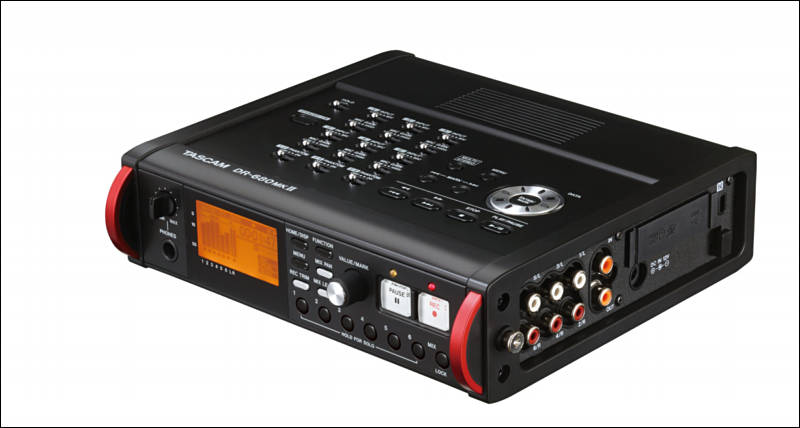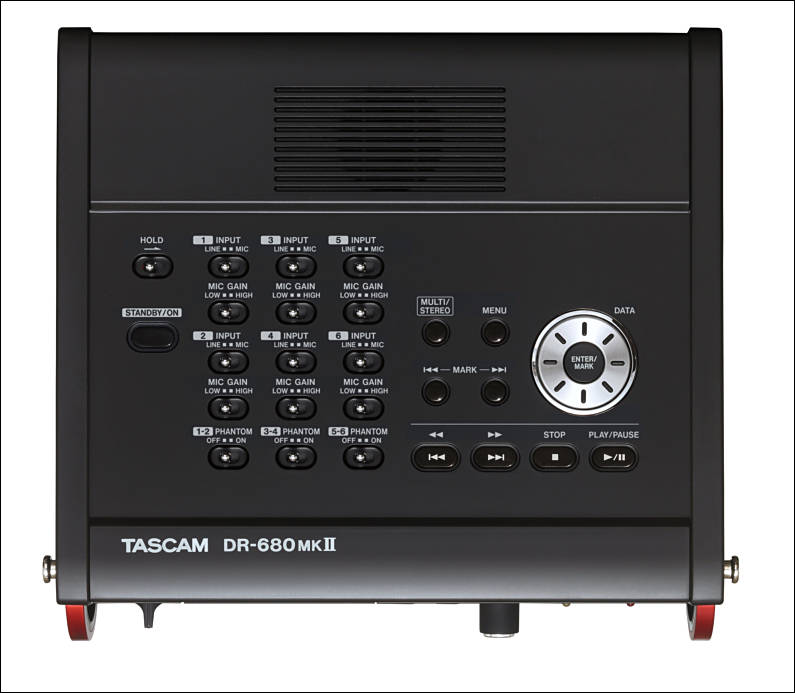
-

Main changes from first version:
- Improved audio quality
Through extended listening tests, a new op-amp and capacitor were selected for the mic preamps to deliver improved audio quality. - Support for SDXC cards
Readily available SD/SDHC cards are used for recording media. The DR-680MKII also supports SDXC cards, which have higher capacities - enabling recording for long periods of time. - Take (file) numbers can be reset using the "Take No. Init" function
The numbers added to recorded file names can be reset. Resetting the take numbers used for each recorded scene is now possible, making file management even easier. - Improved battery life
The newly improved battery life of the DR-680mkII means that the battery now lasts 150% longer than previous DR-680. - Improved clock precision
The precision of the built-in clock oscillator has been improved – making synchronization more accurate when used with video devices. - Dual recording function allows two files to be recorded simultaneously at different levels.
A second file can be recorded simultaneously at a lower level for a distortion-free safety track. This allows you to set the recording level high and make a backup recording at a lower level in case of an unexpected sudden increase in sound level, which may create distortion in the primary file. The DR-680MKII can make −12dB backup recordings of audio input through inputs 1, 3 and 5. - Playback of multitrack recordings.
The DR-680MKII can load multitrack audio files. Multitrack materials (multiple mono files) prepared with a DAW, for example, can be played back. - Support for lithium batteries
In addition to alkaline and NiMH batteries, lithium batteries - which can provide extended power - are supported.
More info - http://tascam.com/product/dr-680mkii/

Features
- SD/SDHC/SDXC cards used as recording/playback media
- 6 balanced mic/line inputs (1-4: XLR/TRS combo jacks, 5-6: TRS jacks)
- 6 unbalanced outputs (RCA pin jacks)
- COAXIAL digital input and output (S/PDIF, AES/EBU)
- Recording/playback formats: BWF, WAV, MP3
- With BWF format, recording starting times can be stored in files
- 8-track recording at 24-bit/96kHz (BWF, WAV)
6 mic/line inputs and stereo mix recording or 6 mic/line input and digital stereo recording •Record MP3 files at 96, 128, 192 and 320 kbps - Record 4-channel MP3 files
- From 4 mic/line inputs (XLR/TRS combo jacks) or 2 mic/line inputs and digital stereo inputs •2-track recording at 24-bit/192kHz (BWF, WAV)
- From 2 mic/line inputs or digital stereo inputs •Digital inputs and outputs support double speed 96 kHz and quad speed 192 kHz
- Sampling frequencies
44.1, 48, 96, 192 kHz (BWF, WAV) 44.1, 48 kHz (MP3) •Quantization bit depth: 16/24-bit (BWF, WAV) - 6 channels of TASCAM HDDA mic preamps for high audio quality with 48V phantom power
- Limiter and low-cut filter available on each mic/line input
- Built-in stereo monitoring mixer for headphone mix and/or recording
- Dual recording function allows two files to be recorded simultaneously at different levels
- GANG function allows the input gain of multiple channels to be operated simultaneously
- Pre-recording function allows the capture of audio two seconds before recording is started
- Automatic recording function can start and stop recording automatically in response to the input signal level (−48, −24, −12 or −6 dB)
- Even when multiple tracks are used, all recordings made at the same time can be managed as a single take/file
- Track incrementation allows a recording to be split by creating a new file at the desired point without interrupting recording
- Up to 1000 takes and 5000 files can be recorded on a single card
- Mark function can be used to move to specific points (up to 99 marks per take)
- Wheel can be used to change the playback position
- Repeat playback function
- Panel lock function to prevent misoperation
- Cascade function allows transport control of multiple DR-680MKII units using a master unit
- File name format can be set to use a user-defined word or the date
- High-speed transfer of files to a computer using USB 2.0
- 128×64-dot matrix display with backlight
- Built-in mono speaker with 500mW output
- Headphone output and level control (50mW+50mW/ 32ohm)
- Powered by 8 AA batteries or the included AC adapter
- USB cable and shoulder strap included
- Folding stand convenient for tabletop use
- Improved audio quality
-
Dang. Too bad I already have one....
-
Cool:-) I also already have the original one and I'm very happy with it (since I built a V-mount-powertab to not relay on the AA batteries).
But that dual recording function with -12dB is a very very nice feature that can save the shot;-)
-
@DrDave --- I too have MkII envy -- especially on the battery front - mine eats AA's before breakfast. That dual level would be great for live events for when a presenter gets unexpectedly excited.
-
Hmmm..... seems the pre amps in the new mk2 are still not great: https://www.gearslutz.com/board/10973734-post4.html
Can anybody else comment about the DR-680 mk2's pre amps from personal experience?
-
Different people have different definitions of "noisy". Especially consistent and loud on forums are usually recording on wrong levels and pulling it in post.
-
I have a NTG-2 and the signal from that is not too strong.
Best way is to replace NTG 2.
-
@IronFilm I don't have an NTG 2 but I often use ribbon mics with the DR 680. Without going into a long spiel about noise, you can think of a ribbon mic as a noise tester. If the pre is noisy, and you plug a ribbon mic into it, you will seriously hear it. So you can go "line in" to the 680 in any of various ways, if you use the combo connectors there is a two position gain switch, set that to high and then use the trim button to crank up the gain. You probably can get the best result using the onboard P48 phantom power for the Rode. The actual gain/noise you get will depend slightly on the the way the impedance is matched, but you would have the same issue with a dedicated preamp. If you are in California, you can come over and try it, but I compared this box to my expensive stuff and it is totally fine. My reference pre is the Audio Upgrades two channel. OK, this and the Grace 801 sounds a teeny, weeny bit better than the 680 but they are big and expensive. Sadly, I leave them behind.
There's also the DR-70D. Everything is so much cheaper than in the old days. And better. Here's the poop on the 70D https://www.gearslutz.com/board/remote-possibilities-acoustic-music-location-recording/960891-new-very-compact-4ch-recorder-tascam-2.html#post10842631
-
I'm using the DR-680 with a Rode NTG-3, more expensive but very good mic. The difference between the NTG-2 and NTG-3 is night and day. The DR-680 and the NTG-3 play very well together.
I have also used the DR-680 with the MXL FR-300. Cheap mics with "ok" quality ("good" if you consider the price - its hard to find something better in this price range).
Your audio is always only as good as its worst part. If you have the DR-680 get a good mic for it, or its a waste of money.
Oh, and the original DR-680 can also record a -12dB safety track as long as you only use 2 mics. Use the "stereo mix", set one mic to the left and the other to the right channel, trim the levels down (only for the stereo mix down) - thats it. But I don't know how much -12dB is in % - I'm setting it at 75%.
-
My brief 680 II review.
This is a short review, but sweet. Pretty much everything is the same as the original 680, so I will focus on the differences.
First of all, the preamps. Whatever BS you may have heard about the preamps, I am here to tell you that these are monster preamps, not just good but great. They are quiet, they will drive a ribbon mic or any other mic, and the converter-pre hybrid chain is super. So you can just take all the noise blah blah SD blah blah Zoom blah blah and tune all that out, what a relief. And, yes, the pres are studio quality, and yes, they are better than the 70D which is supposedly the same but isn't (but which is still very good), and so on. End of "pre" BS. Problem solved.
Next, a lot of tiny little annoyances have been fixed. So, for example, you can turn the speaker off instead of having to plug in headphones. The menus are a bit tidier. There's a menu button on the front. You can use a bigger SD card. But, basically, it is a 680 with super high quality pres.
What else? Well, for the price it is a total no brainer.
Lastly, if you have an old 680 you can gang the two with a coaxial cable ($3 on eBay, or cheat and use an RCA) and now you have 14 channels. Like the old 680, you can hook up a high end Pre through the digital input to get eight channels on the main box. If you gang them together, the digital "in" on box number two is used for sync so you are limited to 6 inputs, but the full 8 are available for box number one.
Howdy, Stranger!
It looks like you're new here. If you want to get involved, click one of these buttons!
Categories
- Topics List23,993
- Blog5,725
- General and News1,354
- Hacks and Patches1,153
- ↳ Top Settings33
- ↳ Beginners256
- ↳ Archives402
- ↳ Hacks News and Development56
- Cameras2,368
- ↳ Panasonic995
- ↳ Canon118
- ↳ Sony156
- ↳ Nikon96
- ↳ Pentax and Samsung70
- ↳ Olympus and Fujifilm102
- ↳ Compacts and Camcorders300
- ↳ Smartphones for video97
- ↳ Pro Video Cameras191
- ↳ BlackMagic and other raw cameras116
- Skill1,960
- ↳ Business and distribution66
- ↳ Preparation, scripts and legal38
- ↳ Art149
- ↳ Import, Convert, Exporting291
- ↳ Editors191
- ↳ Effects and stunts115
- ↳ Color grading197
- ↳ Sound and Music280
- ↳ Lighting96
- ↳ Software and storage tips266
- Gear5,420
- ↳ Filters, Adapters, Matte boxes344
- ↳ Lenses1,582
- ↳ Follow focus and gears93
- ↳ Sound499
- ↳ Lighting gear314
- ↳ Camera movement230
- ↳ Gimbals and copters302
- ↳ Rigs and related stuff273
- ↳ Power solutions83
- ↳ Monitors and viewfinders340
- ↳ Tripods and fluid heads139
- ↳ Storage286
- ↳ Computers and studio gear560
- ↳ VR and 3D248
- Showcase1,859
- Marketplace2,834
- Offtopic1,320






